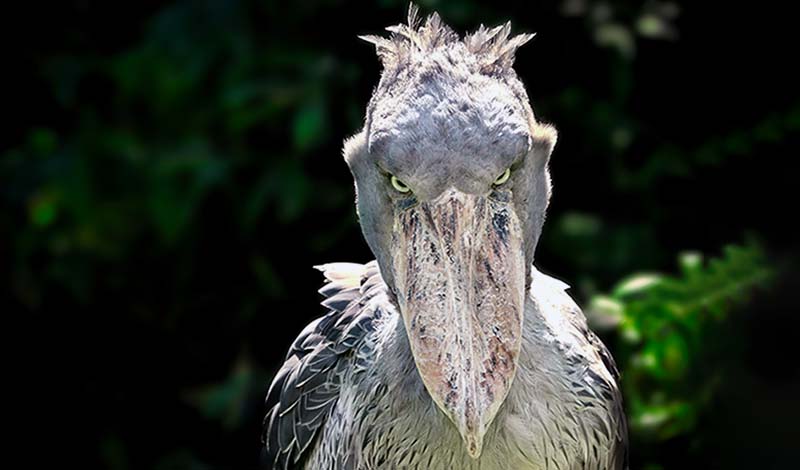2-minute read
If you happened upon a shoebill stork in your travels, your first thought after you stopped shaking in your wading boots would most likely be, “Whoa, that is one super-sized, scarily pre-historic looking bird… dino-bird… bird-o-saur…” Standing five feet tall with a saucer-eyed, do-you-see-how-I-see-you stare and a bone-crusher of a hooked bill, this fearsome swamp dweller is not an escapee from Jurassic Park but a distinctive African wading bird considered one of the most extraordinary feathered creatures on Earth. Let’s dig in to find out what makes the shoebill stork stand out in a flock:
What’s in a Name?
Dubbed Balaeniceps rex, “King Whalehead” or whale-headed stork by British ornithologist John Gould in 1851, the bird was known as abu markub, “father of the shoe” by the Arab people, and schuhschnabel or “shoebill” by the Germans. With a bill shaped like a shoe large enough to hold a human foot, shoebill became the favored moniker. But what kind of shoe? Sneaker? Nope. Stiletto? No. Sandal? Unh-uh. The consensus is that this wading bird’s bill looks like a Dutch clog. Originally grouped with storks, herons, and ibis, scientists have concluded that the shoebill is more closely related to pelicans.
Creature Features
In addition to a powerful 12-inch bill with a piercing nail-like hook on the end, the shoebill has extra-long toes for swamp-stomping and a remarkable eight-foot wingspan.
The Swamp It Calls Home
Found only in the freshwater wetlands of eastern central tropical Africa, the shoebill occupies some of the most inaccessible habitats in the world. The tall, leggy water bird prefers swamps and marshes with lots of reeds and floating vegetation, where it constructs raft-sized nests that can measure up to eight feet across—which, as an aside, is only slightly smaller than a Manhattan studio. Shoebills lay one to three eggs, and it takes about five months for a baby shoebill to mature, leave the nest and stand on its own big bird feet.
Hobbies and Interests
Despite its menacing appearance, the shoebill is no avian warrior. The low-energy, solitary bird spends about 85% of its time standing, preening, and sitting on platforms of vegetation. The sluggish species stands motionless for hours, waiting for a tasty meal to swim by and then collapses on its prey hooked-bill first in a frenzy of wing-flapping. Although the shoebill is capable of flying long distances, it’s not migratory, spends only 0.9% of its time in the air, and only occasionally perches in trees.
Favorite Foods
Most partial to carp and lungfish, the patient fisher-bird is also keen on turtles, water snakes, lizards, and baby crocodiles—also known as the wetlands buffet.
Communication Style
You won’t hear energetic chitter-chattering or soul-stirring swamp songs from the shoebill. The rat-a-tat-tat sound of machine-gun fire it produces is known as bill clattering, and it’s used to both delight lady birds and deter predators. When not on high alert for love or danger, the otherwise quiet bird may offer a gentle nod in greeting. And if you see a shoebill shake its head from side to side, it’s not a judgy sign of disapproval but an attempt to dislodge weedy debris or leftover lungfish.
Shoebill Stressors
Like so many amazing animal species globally, shoebill populations across Africa are declining. Habitat loss, climate change, and illegal capture for the bird trade are taking their toll on the avian wonders. The IUCN estimates that only 3,300 to 5,300 shoebills are left in the wild. As our home planet continues to undergo rapid environmental change, vulnerable animals like the shoebill need all the help they can get to survive. If you’d like to join an international community of people working to create a better world for wondrous wildlife like the shoebill, head on over to Birdlife.org—nature needs more followers!

ICYMI Nature News
Styrofoam Eating Superworms
Move over plastic-eating bacterium, scientists from the University of Queensland have discovered that the larvae of the darkling beetle can survive solely on Styrofoam. Apparently, the little wrigglers prefer a light meal. By all means, dig in!
Turtle-y Not Extinct
Princeton scientists have announced big news for a big tortoise. The Galápagos “fantastic giant tortoise” believed to be extinct for the past 100 years is thankfully still with us. Researchers have located a fifty-year-old female tortoise, which they’ve named Fernanda, and transported her to a rescue and breeding facility for safekeeping. After a half century of keeping herself to herself, we’re glad Fernanda finally came out of her shell.
Polar Bear Work Around
Polar bears in Greenland have come up with a new hunting strategy to compensate for climate change-induced loss of sea ice. It seems these arctic dwellers are smarter than the average bear—although the average bear is smarter than you thought.
You Could Even Say It Glows
Photographer Callie Chee has captured sparkling images of nature’s night lights in a gallery series on bioluminescent lifeforms. Eerily beautiful!
“If Not Now, Then When?”
And the winner of the 2022 Environmental Music Prize is Australian rock artists King Gizzard and the Lizard Wizard for their call-to-action track If Not Now, Then When? When indeed.
That’s all for now Earthlings. Happy summer solstice. Have a super week!




















































